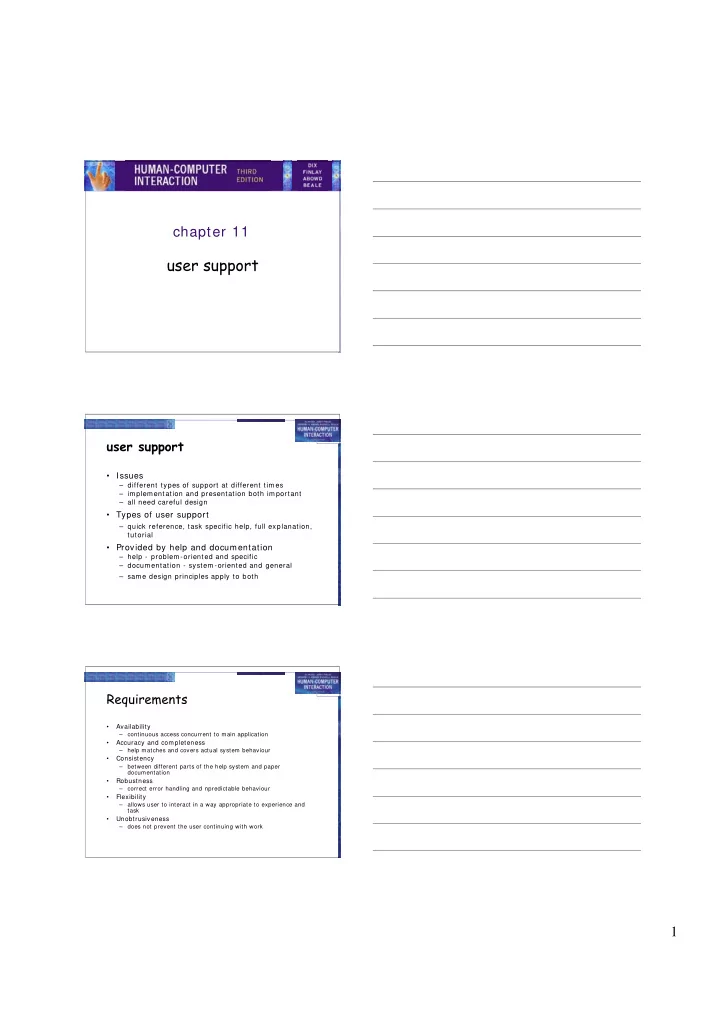

chapter 11 user support user support • Issues – different types of support at different tim es – im plem entation and presentation both im portant – all need careful design • Types of user support – quick reference, task specific help, full explanation, tutorial • Provided by help and documentation – help - problem -oriented and specific – docum entation - system -oriented and general – sam e design principles apply to both Requirements • Availability – continuous access concurrent to main application • Accuracy and completeness – help matches and covers actual system behaviour • Consistency – between different parts of the help system and paper documentation • Robustness – correct error handling and npredictable behaviour • Flexibility – allows user to interact in a way appropriate to experience and task • Unobtrusiveness – does not prevent the user continuing with work 1
Approaches to user support • Com m and assistance – User requests help on particular com m and e.g., UNI X m an, DOS help – Good for quick reference – Assum es user know what to look for • Command prompts – Provide inform ation about correct usage when an error occurs – Good for sim ple syntactic errors – Also assum es knowledge of the com m and Approaches to user support (ctd) • Context sensitive help – help request interpreted according to context in which it occurs. e.g. t ooltips • On-line tutorials – user works through basics of application in a test environm ent. – can be useful but are often in flexible. • On-line docum entation – paper docum entation is m ade available on com puter. – continually available in com m on m edium – can be difficult to browse – hypertext used to support browsing. wizards and assistants • wizards – task specific tool leads the user through task, step by step, using user’s answers to specific questions – example: resumé – useful for safe completion of complex or infrequent tasks – constrained task execution so limited flexibility – must allow user to go back • assistants – monitor user behaviour and offer contextual advice – can be irritating e.g. MS paperclip – must be under user control e.g. XP smart tags 2
Adaptive Help Systems • Use knowledge of the context, individual user, task, dom ain and instruction to provide help adapted to user's needs. • Problem s – knowledge requirem ents considerable – who has control of the interaction? – what should be adapted? – what is the scope of the adaptation? Knowledge representation User modeling • All help systems have a model of the user – single, generic user (non-intelligent) – user-configured model (adaptable) – system-configure model (adaptive) Approaches to user modelling • Quantification – user m oves between levels of expertise – based on quantitative m easure of what he knows. • Stereotypes – user is classified into a particular category. • Overlay – idealized m odel of expert use is constructed – actual use com pared to ideal – m odel m ay contain the com m onality or difference Special case: user behaviour com pared to known error catalogue 3
Knowledge representation Domain and task modelling • Covers – com m on errors and tasks – current task • Usually involves analysis of com m and sequences. • Problem s – representing tasks – interleaved tasks – user intention Knowledge representation Advisory strategy • involves choosing the correct style of advice for a given situation. e.g. rem inder, tutorial, etc. • few intelligent help system s m odel advisory strategy, but choice of strategy is still im portant. Techniques for knowledge representation • rule based (e.g. logic, production rules) – knowledge presented as rules and facts – interpreted using inference mechanism – can be used in relatively large domains. • fram e based (e.g. sem antic network) – knowledge stored in structures with slots to be filled – useful for a small domain. • network based – knowledge represented as relationships between facts – can be used to link frames. • exam ple based – knowledge represented implicitly within decision structure – trained to classify rather than programmed with rules – requires little knowledge acquisition 4
Problems with knowledge representation and modelling • knowledge acquisition • resources • interpretation of user behaviour Issues in adaptive help • I nitiative – does the user retain control or can the system direct the interaction? – can the system interrupt the user to offer help? • Effect – what is going to be adapted and what information is needed to do this? – only model what is needed. • Scope – is modelling at application or system level? – latter more complex e.g. expertise varies between applications. Designing user support • User support is not an ` add on’ – should be designed integrally with the system . • Concentrate on content and context of help rather than technological issues. 5
Presentation issues • How is help requested? – com m and, button, function (on/ off), separate application • How is help displayed? – new window, whole screen, split screen, – pop-up boxes, hint icons • Effective presentation requires – clear, fam iliar, consistent language – instructional rather than descriptive language – avoidance of blocks of text – clear indication of sum m ary and exam ple inform ation Implementation issues I s help What resources are available? – operating system command – screen space – meta command – memory capacity – application – speed Structure of help data I ssues – single file – flexibility and extensibility – file hierarchy – hard copy – database – browsing 6
Recommend
More recommend